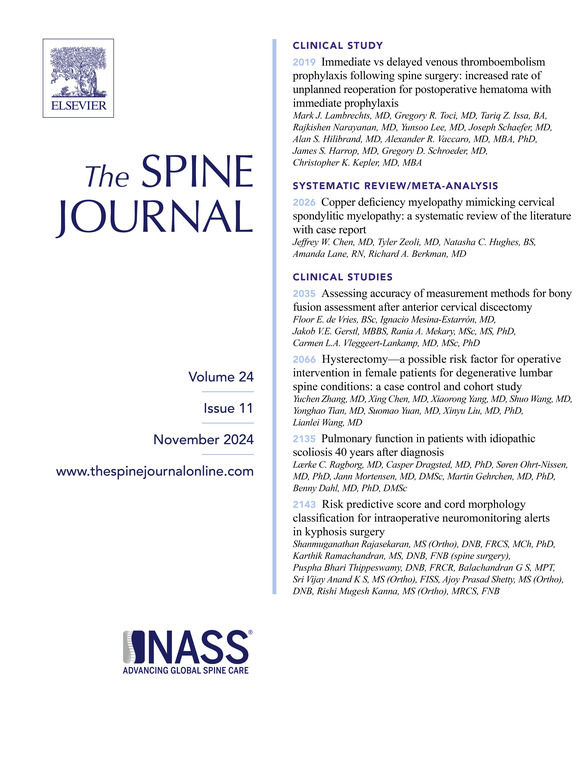Does two-level hybrid surgery promote early fusion compared with two-level anterior cervical discectomy and fusion?
IF 4.7
1区 医学
Q1 CLINICAL NEUROLOGY
引用次数: 0
Abstract
BACKGROUND CONTEXT
Hybrid surgery (HS), which involves both anterior cervical discectomy and fusion (ACDF) and cervical disc replacement (ACDR), is increasingly used to treat multilevel cervical disc degenerative disease, yielding satisfactory clinical outcomes. Early fusion is critical after anterior cervical fusion surgeries, but there are no studies comparing the rate of early fusion of HS with that of ACDF.
PURPOSE
The purpose of this study was to compare the rate of early fusion (3–6 months postoperatively) of two-level HS with that of two-level ACDF surgery.
STUDY DESIGN
The fusion statuses of consecutive patients who underwent two-level ACDF were compared with those of consecutive patients who underwent HS, which involves both ACDF and ACDR.
PATIENT SAMPLE
The study included 860 patients who underwent two-level ACDF or HS for CDDD. After the patients who did not meet the study criteria were excluded, 376 patients were included (165 males, 211 females).
OUTCOME MEASURES
Radiographic measures included fusion rate of the ACDF level. Self-report measures included visual analog scale (VAS) neck, VAS arm, neck disability index (NDI), satisfaction with the surgery and other symptoms reported by patients during the follow-ups.
METHODS
Eight hundred sixty patients who underwent two-level ACDF or HS for cervical disc degenerative disease between January 2015 and January 2023 at our hospital were screened. After excluding the patients who did not meet the study criteria, 376 patients were included (165 males, 211 females). The patients who underwent dual-segment ACDF were categorized into the ACDF-ACDF (FF) group (n=205), while those who underwent dual-segment HS were divided into the ACDF-ACDR (FR) group (n=82) and the ACDR-ACDF (RF) group (n=89) on the basis of the relative positions of the segments selected for ACDF and ACDR. The fusion rates of the segments subjected to ACDF and the clinical outcomes, including the neck VAS score, arm VAS score, NDI score, and other complications, were compared among the three groups at 3 months, 6 months, and 1 year postoperatively. Fusion was defined as the formation of a continuous bone bridge in the target fusion area, as observed on three-dimensional computed tomography (CT) images.
RESULTS
The average age of the patients in the FF group was higher than that of the patients in the FR and RF groups (p<.001). At 3 months postoperatively, the fusion rate was 70.7% (58/82) in the FR group, 39.5% (162/410) in the FF group, and 42.7% (78/89) in the RF group (p<.001). At 6 months postoperatively, the fusion rate was 74.6% (306/410) in the FF group, 91.5% (75/82) in the FR group, and 87.6% (78/89) in the RF group (p<.001). At 1 year postoperatively, the fusion rate was 91.9% (377/410) in the FF group, 98.8% (81/82) in the FR group, and 100% (89/89) in the RF group (p=.002). At 3 months postoperatively, the fusion rate was higher in the FR group than in the FF group (70.7% vs 45.4%) (p<.001). At 6 months postoperatively, the fusion rate of the distal segment was higher in the RF group than in the FF group (87.6% vs 66.3%). In the FF group, the fusion rate in the proximal segment was higher than that in the distal segment at 3, 6, and 12 months postoperatively. One year after surgery, 15 segments—3 proximal and 12 distal—in the FF group developed pseudarthrosis. Compared with the other two groups, the FR group had lower neck VAS scores at 3 months postoperatively and a lower rate of dizziness complaints during the 1-year follow-up period. There were no statistically significant differences in the remaining clinical outcomes.
CONCLUSIONS
The early fusion rate after two-level HS was higher than that after two-level ACDF. The early fusion rate of two-level HS was higher in the FR group than in the RF group. For two-level ACDF, the early fusion rate was higher in the proximal segment than in the distal segment. Additional biomechanical studies are needed to explore the biomechanical differences in fusion levels between HS and multilevel ACDF.
两节段混合手术与两节段前路椎间盘切除术和融合手术相比是否能促进早期融合?
背景背景:混合手术(HS)包括前路颈椎间盘切除术和融合(ACDF)和颈椎间盘置换术(ACDR),越来越多地用于治疗多节段颈椎间盘退行性疾病,取得了令人满意的临床结果。早期融合是颈椎前路融合手术后的关键,但目前还没有研究比较HS和ACDF的早期融合率。目的:本研究的目的是比较两节段HS与两节段ACDF手术的早期融合率(术后3-6个月)。研究设计:比较连续行两级ACDF的患者与同时行ACDF和ACDR的HS患者的融合情况。患者样本:该研究包括860例因CDDD接受两级ACDF或HS治疗的患者。排除不符合研究标准的患者后,共纳入376例患者(男性165例,女性211例)。结果测量:影像学测量包括ACDF水平的融合率。自我报告测量包括颈部视觉模拟量表(VAS)、手臂视觉模拟量表(VAS)、颈部残疾指数(NDI)、手术满意度及患者随访期间报告的其他症状。方法:选取2015年1月至2023年1月在我院行两级ACDF或HS治疗的颈椎间盘退变病患者860例。排除不符合研究标准的患者后,共纳入376例患者(男性165例,女性211例)。双节段ACDF患者分为ACDF-ACDF (FF)组(n=205),双节段HS患者根据ACDF和ACDR选择的节段相对位置分为ACDF-ACDR (FR)组(n=82)和ACDR-ACDF (RF)组(n=89)。比较三组患者术后3个月、6个月、1年的ACDF节段融合率及临床结果,包括颈部VAS评分、上肢VAS评分、NDI评分及其他并发症。在三维计算机断层扫描(CT)图像上观察到,融合被定义为在目标融合区域形成连续的骨桥。结果:FF组患者的平均年龄高于FR组和RF组(p结论:两节段HS术后早期融合率高于两节段ACDF术后。FR组两节段HS的早期融合率高于RF组。对于两节段ACDF,近段的早期融合率高于远段。需要更多的生物力学研究来探讨HS和多节段ACDF融合水平的生物力学差异。
本文章由计算机程序翻译,如有差异,请以英文原文为准。
求助全文
约1分钟内获得全文
求助全文
来源期刊

Spine Journal
医学-临床神经学
CiteScore
8.20
自引率
6.70%
发文量
680
审稿时长
13.1 weeks
期刊介绍:
The Spine Journal, the official journal of the North American Spine Society, is an international and multidisciplinary journal that publishes original, peer-reviewed articles on research and treatment related to the spine and spine care, including basic science and clinical investigations. It is a condition of publication that manuscripts submitted to The Spine Journal have not been published, and will not be simultaneously submitted or published elsewhere. The Spine Journal also publishes major reviews of specific topics by acknowledged authorities, technical notes, teaching editorials, and other special features, Letters to the Editor-in-Chief are encouraged.
 求助内容:
求助内容: 应助结果提醒方式:
应助结果提醒方式:


